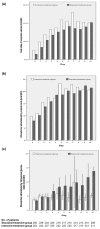Strict glycaemic control in patients hospitalised in a mixed medical and surgical intensive care unit: a randomised clinical trial
- PMID: 18799004
- PMCID: PMC2592751
- DOI: 10.1186/cc7017
Strict glycaemic control in patients hospitalised in a mixed medical and surgical intensive care unit: a randomised clinical trial
Abstract
Introduction: Critically ill patients can develop hyperglycaemia even if they do not have diabetes. Intensive insulin therapy decreases morbidity and mortality rates in patients in a surgical intensive care unit (ICU) and decreases morbidity in patients in a medical ICU. The effect of this therapy on patients in a mixed medical/surgical ICU is unknown. Our goal was to assess whether the effect of intensive insulin therapy, compared with standard therapy, decreases morbidity and mortality in patients hospitalised in a mixed ICU.
Methods: This is a prospective, randomised, non-blinded, single-centre clinical trial in a medical/surgical ICU. Patients were randomly assigned to receive either intensive insulin therapy to maintain glucose levels between 80 and 110 mg/dl (4.4 to 6.1 mmol/l) or standard insulin therapy to maintain glucose levels between 180 and 200 mg/dl (10 and 11.1 mmol/l). The primary end point was mortality at 28 days.
Results: Over a period of 30 months, 504 patients were enrolled. The 28-day mortality rate was 32.4% (81 of 250) in the standard insulin therapy group and 36.6% (93 of 254) in the intensive insulin therapy group (Relative Risk [RR]: 1.1; 95% confidence interval [CI]: 0.85 to 1.42). The ICU mortality in the standard insulin therapy group was 31.2% (78 of 250) and 33.1% (84 of 254) in the intensive insulin therapy group (RR: 1.06; 95%CI: 0.82 to 1.36). There was no statistically significant reduction in the rate of ICU-acquired infections: 33.2% in the standard insulin therapy group compared with 27.17% in the intensive insulin therapy group (RR: 0.82; 95%CI: 0.63 to 1.07). The rate of hypoglycaemia (< or = 40 mg/dl) was 1.7% in the standard insulin therapy group and 8.5% in the intensive insulin therapy group (RR: 5.04; 95% CI: 1.20 to 21.12).
Conclusions: IIT used to maintain glucose levels within normal limits did not reduce morbidity or mortality of patients admitted to a mixed medical/surgical ICU. Furthermore, this therapy increased the risk of hypoglycaemia.
Trial registration: clinicaltrials.gov Identifiers: 4374-04-13031; 094-2 in 000966421.
Trial registration: ClinicalTrials.gov NCT00966421.
Figures



Comment in
-
Tight glycaemic control in the intensive care unit: pitfalls in the testing of the concept.Crit Care. 2008;12(5):187. doi: 10.1186/cc7086. Epub 2008 Oct 24. Crit Care. 2008. PMID: 18957141 Free PMC article.
-
Evidence--lost to tight glycemic control?Crit Care. 2008;12(5):430. doi: 10.1186/cc7022. Epub 2008 Oct 20. Crit Care. 2008. PMID: 18983697 Free PMC article. No abstract available.
References
-
- Robinson LE, van Soeren MH. Insulin resistance and hyperglycemia in critical illness: role of insulin in glycemic control. AACN Clin Issues. 2004;15:45–62. - PubMed
Publication types
MeSH terms
Substances
Associated data
LinkOut - more resources
Full Text Sources
Medical

